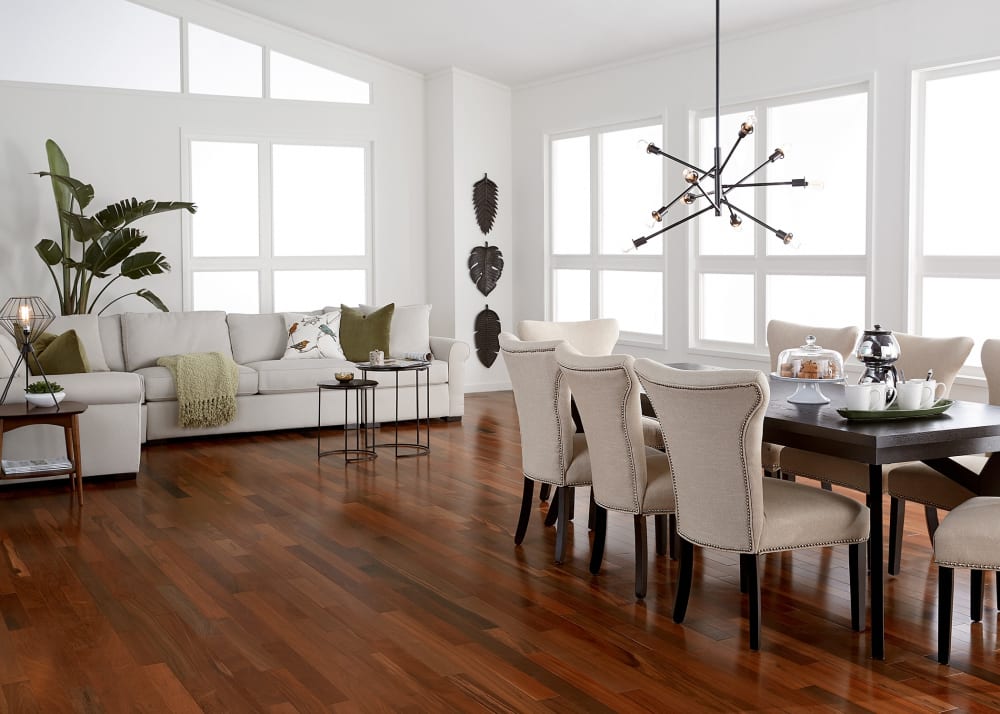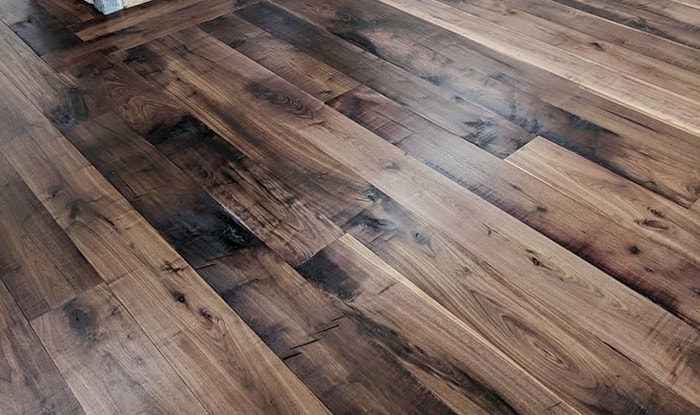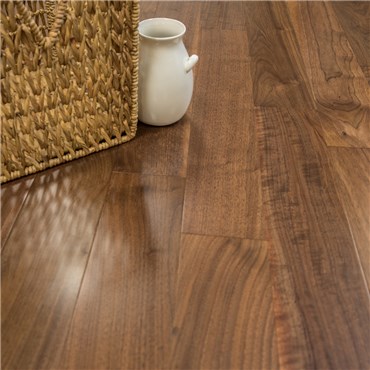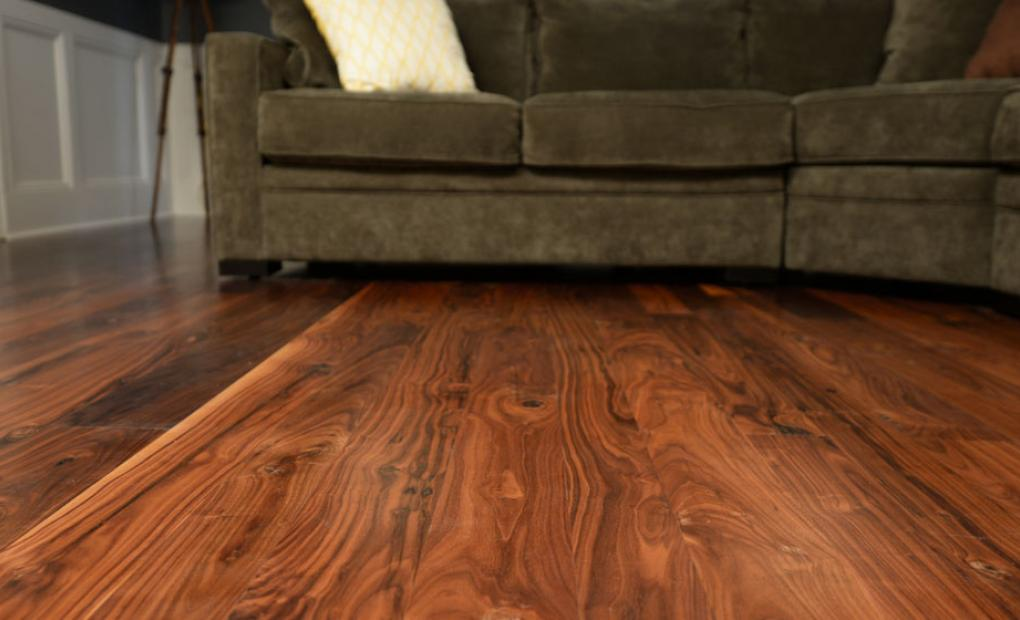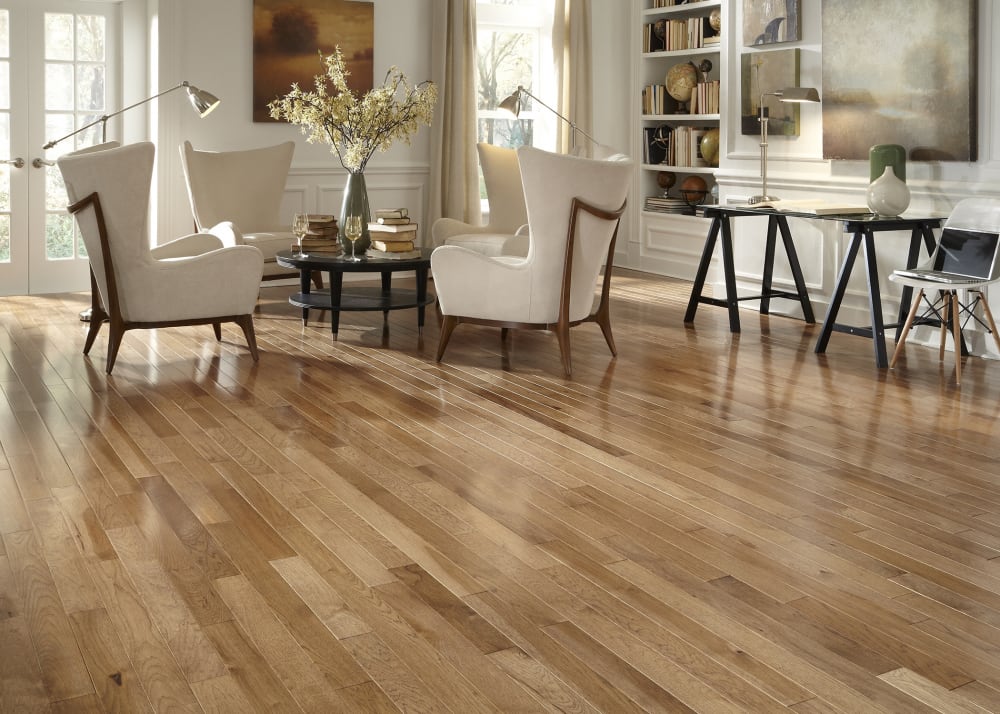The Unique Appeal of Walnut Hardwood Flooring
When it comes to choosing hardwood flooring, walnut is often considered one of the most luxurious and unique options. Its rich color, natural grain patterns, and smooth texture make it stand out in any room, offering both warmth and sophistication. But what exactly sets walnut hardwood flooring apart from other options? Let me walk you through the special qualities that make walnut hardwood flooring a favorite among homeowners and designers alike.
- Rich, Dark Hues Walnut is known for its deep, chocolate-brown tones that darken beautifully over time. It has a natural warmth that creates a cozy, inviting atmosphere. Unlike lighter woods, walnut brings a sense of drama to your space, making it ideal for formal living rooms, dining areas, and bedrooms.
- Natural Grain Patterns The grain patterns in walnut flooring are intricate and elegant. Each plank is unique, showcasing swirls, curls, and waves that give the floor a dynamic, organic look. The natural variation in walnut’s grain makes it easy to blend with various interior styles, from traditional to contemporary.
- Smooth, Velvety Texture Walnut hardwood has a finer grain and smoother finish compared to many other hardwoods. This gives the flooring a velvety texture underfoot, adding a tactile element to its visual beauty. The smoothness makes it perfect for barefoot walking, enhancing the comfort of your home.
- A Luxurious, High-End Feel Walnut has long been associated with luxury and sophistication. Historically, it was used in high-end furniture, cabinetry, and flooring in grand homes and estates. Its high-quality look and feel can instantly elevate the aesthetic of any space, adding a touch of elegance.
- Timeless Beauty One of the reasons walnut hardwood flooring is so popular is its timeless appeal. It doesn’t follow fleeting design trends; instead, it offers a classic beauty that ages gracefully. Whether your home décor is modern or vintage-inspired, walnut will seamlessly blend in and continue to look beautiful for decades.
- Versatility Across Different Décor Styles The unique appeal of walnut also lies in its versatility. Whether you’re going for a minimalist, rustic, or eclectic look, walnut complements almost any design aesthetic. Its ability to pair with various materials like marble, metal, or glass makes it a flexible choice for both traditional and modern interiors.

Benefits of Choosing Walnut for Your Home
Choosing the right hardwood flooring can be overwhelming, especially when you want a balance of durability, aesthetics, and long-term value. Walnut hardwood flooring is an option that ticks all these boxes. Let’s explore the benefits of choosing walnut for your home and why it might just be the perfect fit for your flooring needs.
Luxurious Appearance One of the most significant advantages of walnut flooring is its luxurious appearance. The rich, deep tones create a warm and welcoming ambiance. The natural sheen of walnut also adds an extra layer of sophistication to any room, making your home look polished and high-end.
Durability and Strength Walnut is not just beautiful; it’s also durable. While it may not be the hardest wood available, it holds up well to daily wear and tear, especially in lower-traffic areas like bedrooms and dining rooms. With proper care, walnut floors can last for decades, maintaining their elegance over the years.
Easy to Maintain Maintenance is an important factor when choosing any flooring, and walnut doesn’t disappoint. Its natural dark color does a good job of hiding dirt and minor scratches, meaning you won’t have to clean it as frequently. Regular sweeping and occasional mopping will keep your walnut floors looking as good as new.
Comfort Underfoot Walnut flooring is softer than some other hardwoods, which makes it more comfortable to walk on. Its smooth, even texture gives it a luxurious feel underfoot, perfect for homes where people often walk barefoot. It’s also a great option if you want a hardwood that’s not too hard or cold to the touch.
Improves Home Value Hardwood flooring is always a good investment, but walnut takes it to the next level. The high-end look of walnut can boost your home’s resale value and make it more appealing to potential buyers. If you’re considering selling in the future, walnut floors could be a major selling point.
Natural Warmth and Insulation Walnut wood is a natural insulator, helping to keep your home warm. In colder months, walnut flooring can contribute to a cozier environment by retaining heat. This natural insulation is not only comfortable but can also help you save on heating bills in the long run.
Types of Walnut Hardwood Flooring: American vs. Brazilian
Walnut hardwood flooring comes in two primary types: American and Brazilian walnut. While both options are stunning, they each offer distinct characteristics that cater to different tastes and needs. Understanding the differences between American and Brazilian walnut can help you make a more informed decision when choosing your flooring. Let’s break down the unique aspects of each type.
Color Variations American walnut, also known as Black Walnut, typically has a rich, dark brown color with a slightly purple or gray undertone. Its color deepens over time, giving it a more classic and mature appearance. Brazilian walnut, also called Ipe, is generally much darker from the start and can range from dark brown to olive green, creating a more dramatic look.
Density and Durability When it comes to density, Brazilian walnut is one of the hardest woods available. It scores much higher on the Janka hardness scale than American walnut, making it incredibly durable and resistant to dents and scratches. This makes Brazilian walnut a great choice for high-traffic areas or homes with kids and pets. American walnut, on the other hand, is softer, making it more prone to minor wear but also easier to work with during installation.
Grain Patterns American walnut has a straight grain pattern with occasional wavy lines, giving it a softer, more subtle appearance. In contrast, Brazilian walnut has a more varied and intricate grain, often featuring interlocking patterns. This makes Brazilian walnut ideal for those looking to add visual interest to their floors.
Cost Considerations Brazilian walnut tends to be more expensive than American walnut due to its higher density and exotic nature. If you’re looking for an affordable yet beautiful option, American walnut might be the better choice. However, if durability and a truly unique look are priorities, the investment in Brazilian walnut could be worth it.
Environmental Impact American walnut is more sustainable, as it’s typically sourced from forests in North America, where reforestation efforts are common. Brazilian walnut, while durable, often comes from rainforests, raising concerns about deforestation. If environmental impact is a key consideration for you, American walnut is the more eco-friendly option.
Best Uses for Each Type American walnut is ideal for formal spaces, bedrooms, or areas where you want to highlight the wood’s natural beauty. Its softer feel and classic look are perfect for rooms with moderate foot traffic. Brazilian walnut, with its hardness and rich color, is best for high-traffic areas like hallways, kitchens, or commercial spaces where durability is key.
Durability and Longevity of Walnut Flooring
When investing in hardwood flooring, durability, and longevity are often top of mind. Walnut, with its rich appearance and lasting appeal, is an excellent choice if you’re looking for a floor that will stand the test of time. Let’s explore how walnut hardwood flooring measures up in terms of wear, longevity, and overall resilience.
Natural Hardness and Durability While walnuts may not be as hard as some other hardwoods like oak or hickory, they offer reasonable durability for everyday use. American walnut, the softer of the two main types, is still tough enough to withstand normal household activity, especially in areas with moderate foot traffic. Brazilian walnut, on the other hand, is one of the hardest woods available, making it extremely resistant to dents, scratches, and other forms of damage.
Aging Gracefully Walnut has the unique ability to age gracefully. Over time, its color deepens, giving the floor an even richer and more luxurious look. While some hardwoods fade with exposure to sunlight, walnut tends to darken, enhancing its natural beauty rather than diminishing it. This means your walnut floors will continue to look stunning for years to come.
Scratch Resistance Although American walnut is not as hard as some other options, it’s still resistant to minor scratches and scuffs. Its natural dark color also helps mask any imperfections that may occur over time. However, if you have pets or children, Brazilian walnut might be the better choice due to its higher hardness rating and resistance to more significant wear and tear.
Longevity with Proper Care With proper care, walnut hardwood floors can last for decades, making them a long-term investment. Regular maintenance, such as sweeping to remove debris and using rugs in high-traffic areas, can help preserve the floor’s finish. Walnut flooring can also be refinished multiple times throughout its life, ensuring it continues to look fresh even after years of use.
Resisting Warping and Moisture Damage Walnut hardwood flooring is naturally resistant to warping, making it a stable choice for most environments. However, like all wood floors, it’s important to avoid excessive moisture exposure. Installing a moisture barrier and keeping humidity levels in check will prevent potential damage and prolong the life of your walnut floors.
Enhancing the Value of Your Home Walnut flooring not only offers durability but also enhances the overall value of your home. Its luxurious appearance and long-lasting appeal make it a selling point for potential buyers. A well-maintained walnut floor can significantly boost the marketability of your home, giving you a high return on your investment.
How to Care for Walnut Hardwood Floors
Taking care of your walnut hardwood floors doesn’t have to be a chore, but it does require some attention to maintain their beauty and longevity. With the right care, your walnut floors can remain stunning for years. Here’s a simple guide to help you keep your walnut hardwood in tip-top shape.
Regular Cleaning Routine The key to maintaining walnut floors is keeping them clean. Dust and dirt can act like sandpaper, scratching the surface of your floors over time. Sweeping your floors daily or using a vacuum cleaner designed for hardwood will help prevent debris from accumulating. You don’t need to use harsh chemicals; a simple dry mop or soft-bristled broom will do the trick.
Avoiding Water Damage Like most hardwood floors, walnuts are sensitive to moisture. While walnut is more stable than some other types of wood, it’s still important to avoid excessive water. When mopping, use a damp (not wet) mop and immediately dry the surface afterward. Spills should be cleaned up right away to prevent any water from seeping into the wood and causing warping or staining.
Using Rugs in High-Traffic Areas High-traffic areas like hallways or entryways are prone to more wear and tear. Placing rugs or runners in these areas can help protect your walnut floors from scratches and scuffs. Make sure to use rugs with a soft backing to avoid damaging the floor’s finish. Rugs are also great for catching dirt and moisture before they get tracked throughout the house.
Furniture Protection Heavy furniture can cause dents or scratches on hardwood floors. To avoid this, place felt pads under the legs of chairs, tables, and couches. If you need to move furniture, lift it instead of dragging it across the floor to prevent any accidental gouging or scratching.
Refinishing When Necessary Over time, even the best-maintained walnut floors may start to show signs of wear. The good news is that walnut flooring can be sanded and refinished multiple times, bringing it back to its original beauty. Depending on the level of traffic in your home, you may want to consider refinishing your floors every 5–10 years to keep them looking fresh and vibrant.
Maintaining the Right Humidity Levels Walnut flooring, like all hardwood, expands and contracts with changes in humidity. To prevent your floors from warping or developing gaps, it’s important to maintain a consistent humidity level in your home. A humidifier in the winter and a dehumidifier in the summer can help keep your floors stable and in good condition.
Walnut Flooring: Installation Tips and Considerations
Installing walnut hardwood flooring is a big project, but with careful planning, it can be a rewarding experience. Whether you’re tackling the installation yourself or hiring professionals, there are some important factors to consider to ensure your walnut floors turn out beautifully. Here’s a guide to help you through the installation process.
Preparing the Subfloor Before installing walnut hardwood, it’s crucial to ensure your subfloor is clean, dry, and level. Any bumps or imperfections in the subfloor can affect the appearance and stability of your hardwood. Depending on the condition of your subfloor, you may need to sand or repair it to create a smooth surface for the walnut planks.
Acclimating the Wood Hardwood flooring needs to acclimate to the environment in which it will be installed. Walnut planks should be brought into the room where they’ll be installed and allowed to sit for at least 48–72 hours. This allows the wood to adjust to the room’s humidity and temperature, reducing the risk of warping or gaps after installation.
Choosing the Right Installation Method There are a few different methods for installing walnut hardwood flooring, including nail-down, glue-down, or floating installation. The method you choose will depend on the type of subfloor and your personal preference. Nail-down is a traditional method that provides a secure fit, while floating installations are easier and faster, especially for DIY projects.
Staggering the Planks To create a more natural and aesthetically pleasing look, it’s important to stagger the planks during installation. This means making sure that the end joints of the planks are not lined up in a straight row. Staggering the joints helps create a more random, natural appearance and strengthens the overall floor structure.
Finishing Touches Once the walnut flooring is installed, finishing touches like baseboards, moldings, and transitions should be added to complete the look. These elements help hide the gaps between the floor and the wall and give your room a polished appearance. Make sure to choose moldings and trims that complement the walnut’s rich color and natural grain.
Post-Installation Care After installation, it’s important to care for your new walnut floors properly. Avoid walking on the floors for at least 24 hours to allow any adhesive to set. Once the floors are ready, apply a hardwood floor cleaner and follow a regular maintenance routine to keep them looking pristine.
Walnut Hardwood Flooring: A Timeless Design Choice
One of the most compelling reasons to choose walnut hardwood flooring is its timeless appeal. Unlike trends that come and go, walnut has been a staple in high-end homes for centuries, and it continues to be a popular choice today. Let’s take a closer look at why walnut hardwood flooring remains a timeless design choice.
Classic Beauty Walnut’s deep, rich tones are undeniably elegant. Its natural color variation and luxurious grain patterns give it a classic beauty that transcends design trends. Whether your home décor is traditional, modern, or somewhere in between, walnut flooring can effortlessly complement your style and add a touch of sophistication.
Adapts to Changing Styles One of the most significant benefits of walnut flooring is its versatility. As design preferences evolve over the years, your walnut floors will continue to blend seamlessly with new styles. Whether you decide to change your wall colors, furniture, or overall aesthetic, walnut will remain a constant, timeless backdrop.
Suits Various Room Types Walnut’s adaptability extends beyond design styles—it works beautifully in a variety of rooms. From living rooms and dining areas to bedrooms and home offices, walnut flooring adds warmth and character to any space. Its durability makes it suitable for both high-traffic areas and more private spaces, ensuring that your entire home can enjoy the beauty of walnut.
Long-Lasting Value Investing in walnut hardwood flooring is not just about immediate aesthetics; it’s about long-term value. Walnut’s ability to maintain its beauty over time means you won’t have to worry about replacing or updating your floors. In fact, walnut flooring often improves with age, developing a patina that enhances its natural appeal.
Sustainable and Eco-Friendly As more homeowners become conscious of sustainability, walnut hardwood flooring stands out as an eco-friendly choice. American walnut, in particular, is harvested from well-managed forests, ensuring that it’s a renewable resource. Choosing walnut for your home means you’re investing in a sustainable material that also reduces the need for future replacements.
An Investment in Elegance Walnut hardwood flooring is more than just a practical choice—it’s an investment in elegance. Its timeless beauty, durability, and ability to adapt to changing styles make it a flooring option that never goes out of fashion. Whether you’re designing a new home or renovating an existing space, walnut floors offer a timeless elegance that will continue to impress for years to come.
Discount 5″ x 5/8″ American Walnut Select u0026 Better 4mm Wear Layer
Walnut Natural Prime Grade Hardwood Flooring
Walnut Flooring: Add Dark, Rich Color to Your Floors
Builder’s Pride 3/4 in. Walnut Hickory Solid Hardwood Flooring
Related Posts:
